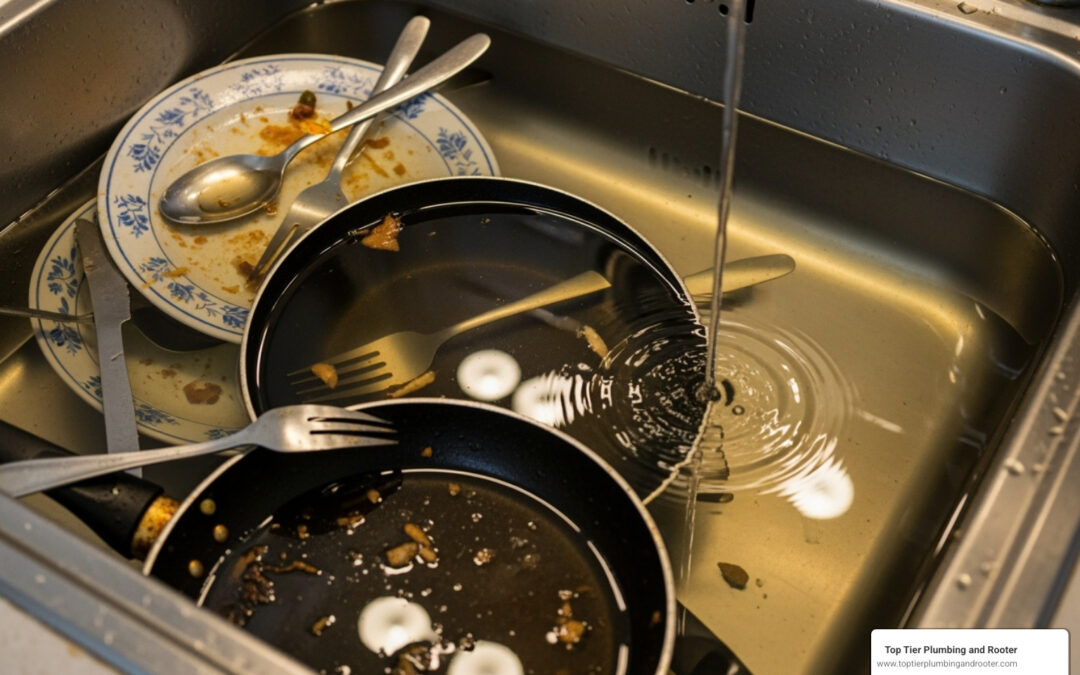Why a Blocked Kitchen Sink Disrupts Your Daily Routine
A blocked kitchen sink is a frustrating plumbing problem. The standing water, slow drainage, and unpleasant odors can quickly make your kitchen unusable, disrupting meal prep and cleanup.
Quick Solutions for a Blocked Kitchen Sink:
- Boiling Water – Pour slowly down the drain to melt grease buildup
- Baking Soda & Vinegar – Natural chemical reaction breaks down clogs
- Sink Plunger – Creates suction to dislodge blockages near the surface
- P-Trap Cleaning – Remove and clean the curved pipe under your sink
- Drain Snake – Physically break up deeper clogs in the pipe
The main culprits behind kitchen sink clogs include:
- Grease and cooking oil that solidify in pipes
- Food scraps like rice, pasta, and potato peels
- Coffee grounds that clump together
- Soap scum buildup over time
While most blocked sinks can be cleared with simple DIY methods, persistent clogs or multiple blocked drains may signal a deeper issue requiring professional attention.
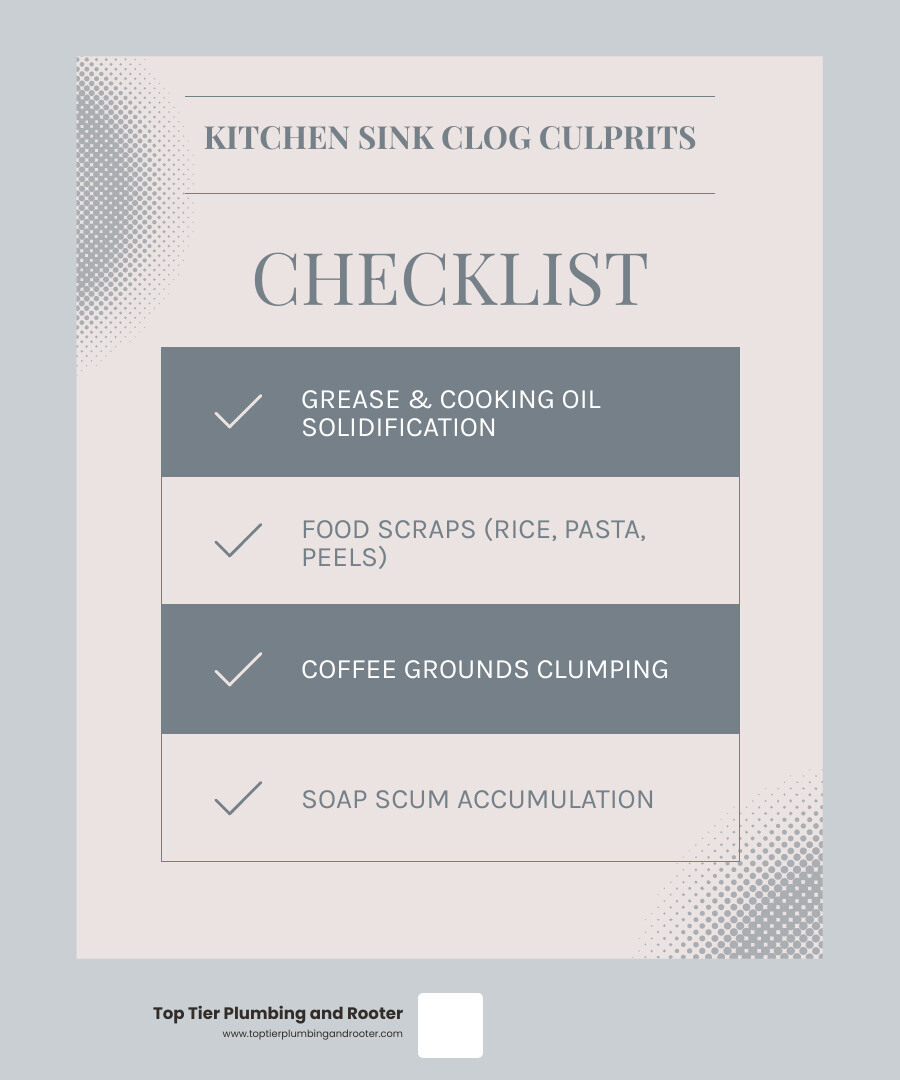
Signs and Common Causes of a Blocked Kitchen Sink
A blocked kitchen sink rarely happens overnight. Your sink usually provides warning signs before it clogs completely. Learning to recognize these early signals can save you from a major plumbing headache.
Recognizing the Telltale Signs
Your kitchen sink communicates when something is wrong. Here’s what to look for:
Slow drainage is the first clue. If water takes longer than usual to drain, your pipes are developing a clog. It’s much easier to fix a slow drain than a completely blocked one.
Gurgling sounds happen when air gets trapped by a partial blockage and bubbles up through the water. Think of it as your drain trying to clear its throat.
Unpleasant odors are a giveaway that food particles and grease are stuck and decomposing in your pipes, making your kitchen uninviting.
Standing water is the final sign that your sink won’t drain at all. You’ve moved from a minor inconvenience to a major problem that needs immediate action.
Sometimes you might notice water backing up into your sink, especially when running the dishwasher. This indicates a severe blockage that is forcing water back up the drain.
Understanding the Main Culprits
Now that you know the signs, let’s identify the usual suspects behind your blocked kitchen sink.
Grease and cooking oil are the number one cause. When hot grease is poured down the drain, it cools and solidifies on pipe walls. This waxy buildup traps other debris, creating stubborn blockages.
Food scraps are also problematic. Starchy foods like rice and pasta expand in water, forming a gluey mass. Fibrous vegetables like celery and onion skins can tangle with other debris to form clogs.
Coffee grounds are often misunderstood. They don’t dissolve but instead clump together like wet sand, creating dense blockages.
Soap scum can combine with grease and food particles, creating a sticky coating that worsens clogs.
Occasionally, foreign objects like a dropped spoon or bottle cap can cause an immediate, complete blockage.
Understanding these causes is the first step toward prevention. For more tips, see our guide on The Best Ways to Prevent Clogged Drains in Your Kitchen and Bathroom. Most blockages can be prevented with simple changes to your kitchen habits.
5 DIY Methods to Clear Your Sink
Before calling a plumber for a blocked kitchen sink, try these simple DIY methods. Most clogs can be cleared with items you already have at home. We’ve organized five proven methods to help you choose the right approach.
| Method | Pros | Cons | Best Use Cases |
|---|---|---|---|
| Boiling Water | Simple, inexpensive, environmentally friendly | Not for all pipe types (PVC, composite sinks), may not work for tough clogs | Minor grease clogs, slow drains |
| Baking Soda & Vinegar | Natural, safe for pipes, removes odors, environmentally friendly | Best for minor clogs, not effective for solid objects or severe blockages | Soap scum, minor food particle buildup, odors |
| Plunger | Effective for many clogs, quick, no chemicals | Requires good seal, less effective for deep clogs, can be messy | Near-surface clogs, food particles |
| P-Trap Cleaning | Directly removes clog, effective for physical obstructions | Requires tools, can be messy, involves disassembly | Solid objects, accumulated sludge |
| Drain Snake | Reaches deeper clogs, effective for many clog types | Can scratch pipes if not used carefully, requires some skill, can be messy | Hair, tangled food, deeper blockages |
Safety first! Always turn off your garbage disposal, wear gloves, have towels ready, and never mix chemical cleaners.
Method 1: Boiling Water
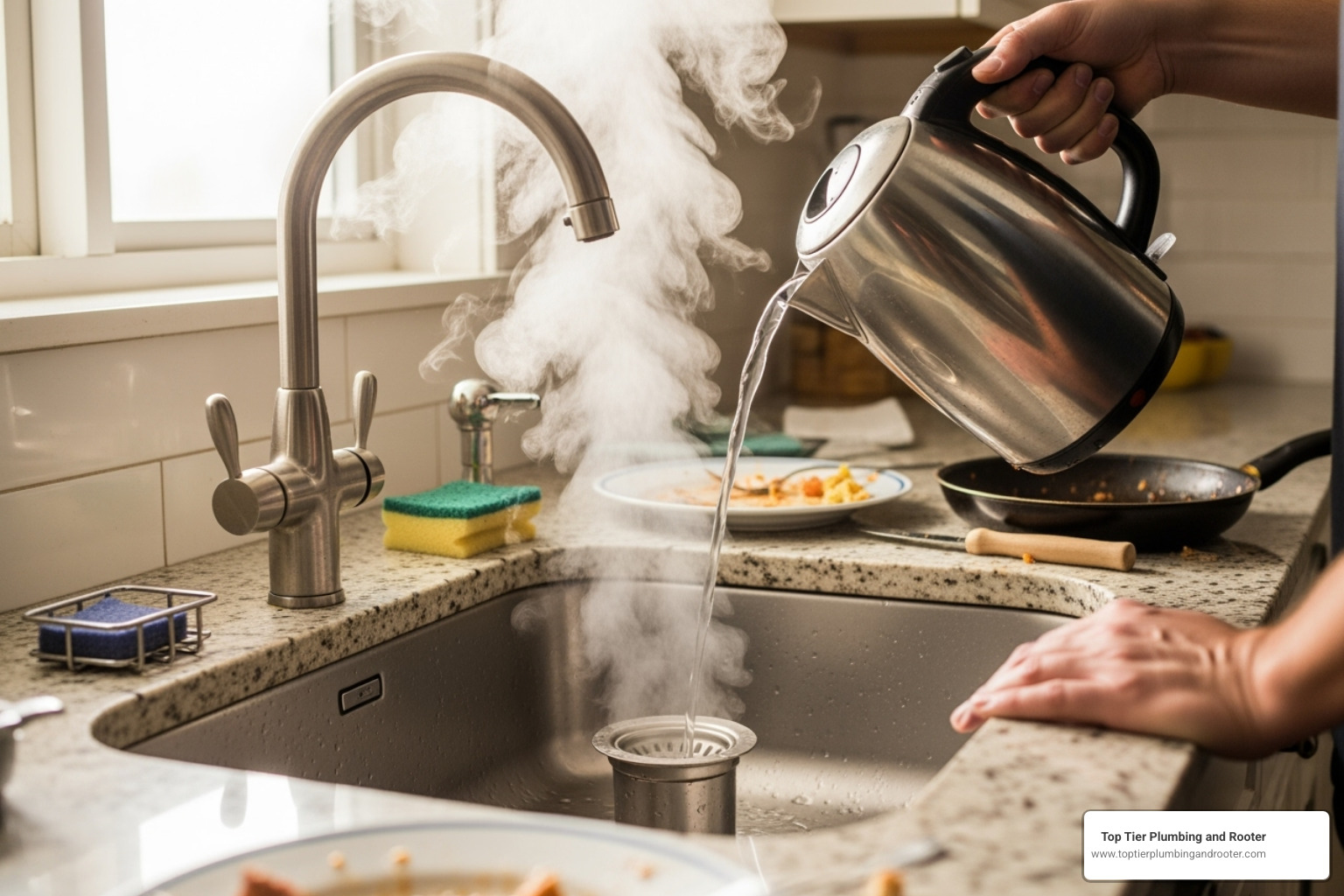
For slow drains caused by grease, boiling water is a simple first step. It works by melting congealed fats in the pipes. First, remove any standing water. Then, carefully pour a kettle of boiling water down the drain in a few stages, pausing between pours to let the heat work. Test the drain after a few minutes.
Important warning: Never use boiling water on PVC pipes or composite sinks, as the heat can cause damage. This method is safest for metal pipes. If unsure, use very hot tap water instead.
Method 2: Baking Soda and Vinegar
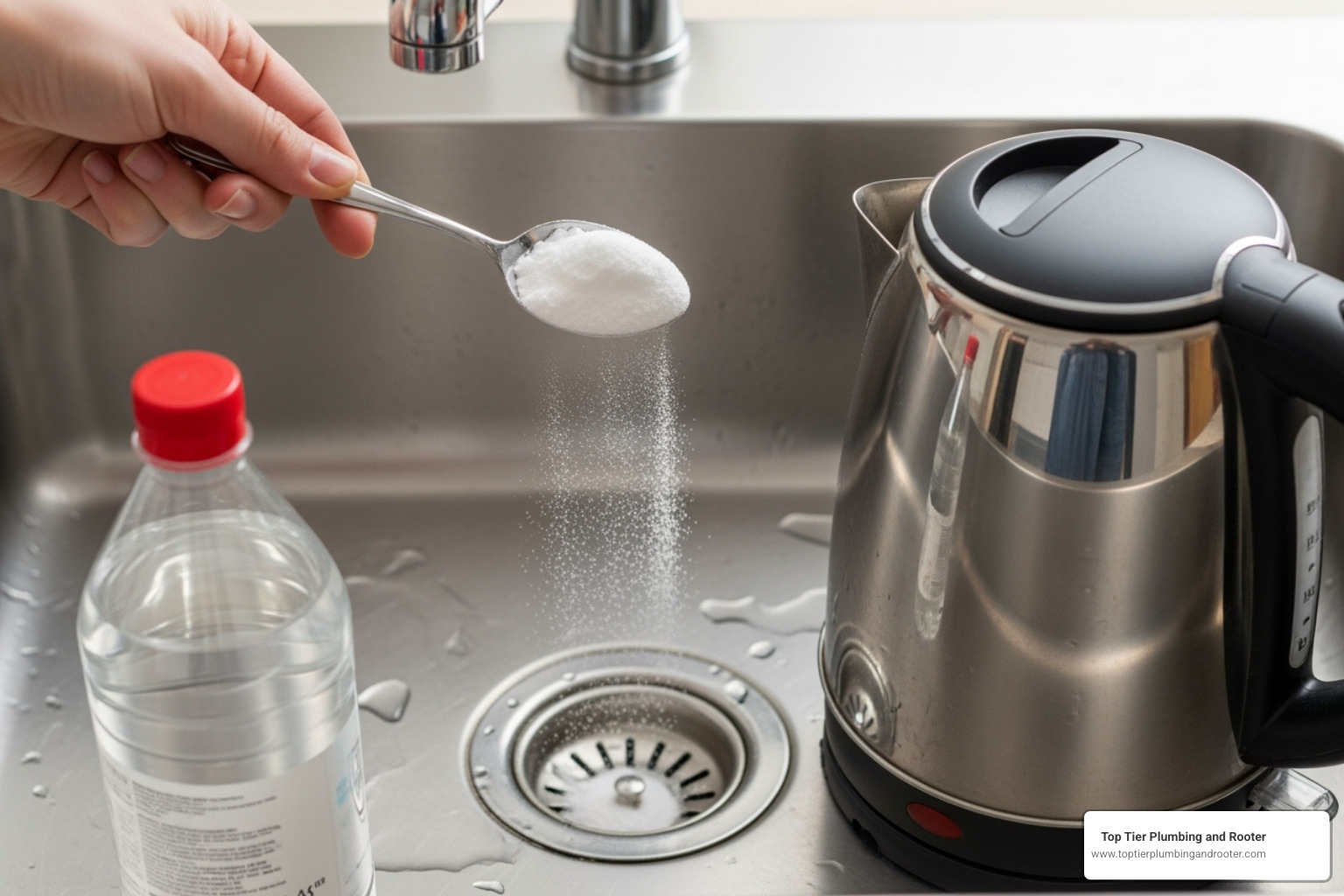
This classic home remedy uses a chemical reaction to break down minor clogs and freshen the drain. The fizzing creates pressure that helps dislodge debris. Start by removing standing water. Pour one cup of baking soda down the drain, followed by one cup of white vinegar. Immediately cover the drain to trap the reaction inside. Let it work for 15 to 30 minutes, then flush with hot water.
This method is great for soap scum and minor food clogs, and it also eliminates odors. It’s safe for all pipes and can be used monthly for prevention.
Method 3: The Plunger
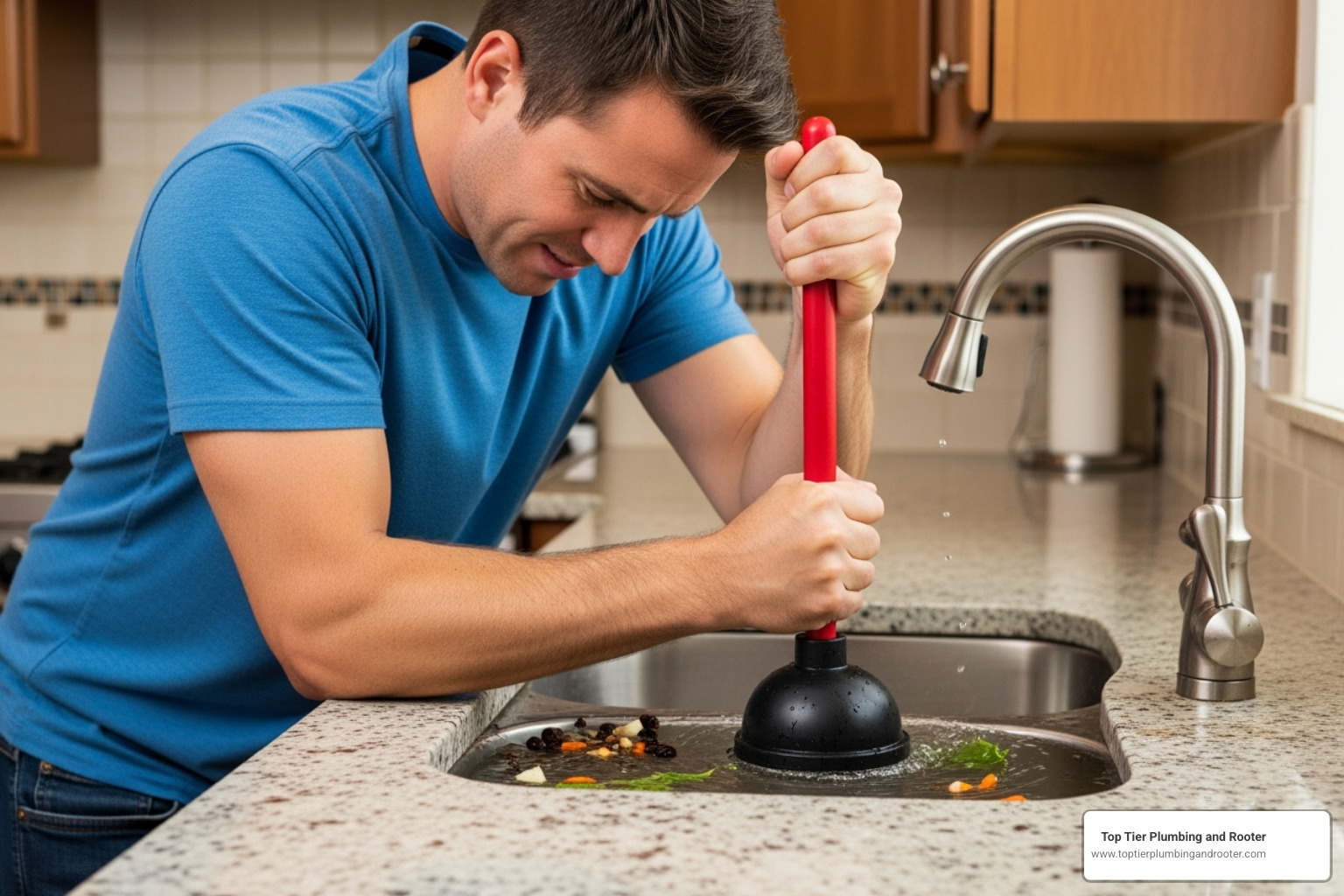
A plunger is a powerful tool for near-surface clogs. It’s crucial to use a sink plunger (with a flat cup), not a toilet plunger, to create a proper seal. Remove the drain strainer and ensure there’s enough water in the sink to cover the plunger’s cup.
If you have a double sink, securely plug the other drain with a wet rag to ensure pressure is directed at the clog. Position the plunger over the drain to create a seal. Plunge vigorously up and down 10 to 12 times, then quickly pull the plunger away. Repeat if necessary. For more stubborn plumbing challenges, check out our guide on Common Plumbing Issues and How to Fix Them.
Method 4: Cleaning the P-Trap
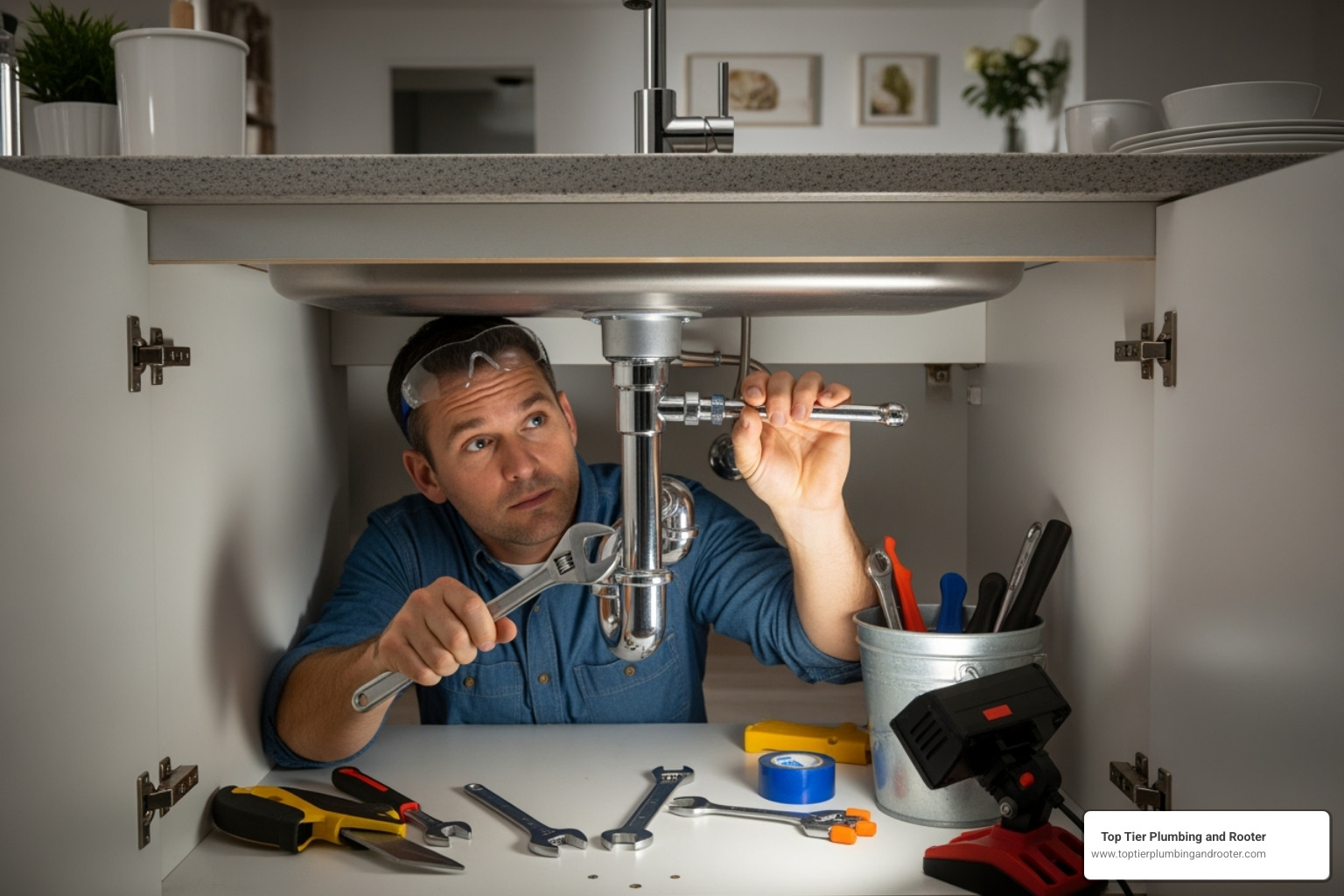
If other methods fail, the clog may be in the P-trap, the U-shaped pipe under your sink. Its curve traps debris, making it a common spot for blockages. You’ll need a bucket, wrench or pliers, gloves, and towels. Place the bucket under the P-trap to catch water and debris. Use a wrench to loosen the slip nuts on both ends and remove the trap.
Inspect the inside of the P-trap and use a small brush or your gloved hands to remove any visible blockages. Rinse the trap thoroughly. When reinstalling, tighten the nuts securely but don’t over-tighten, which can crack plastic pipes. Run water to check for leaks.
Method 5: Using a Drain Snake for a Stubbornly Blocked Kitchen Sink
For a stubborn blocked kitchen sink with a clog deep in the pipes, a drain snake (or plumbing auger) is an effective tool. Manual drain snakes are inexpensive and consist of a flexible cable with a crank handle and a corkscrew tip. For best results, remove the P-trap first to access the drainpipe directly.
Feed the snake’s cable into the pipe until you feel resistance. Tighten the thumbscrew to lock the cable, then turn the handle clockwise to break up or hook the clog. Slowly retract the snake. After clearing the blockage, reinstall the P-trap (if removed) and flush the drain with hot water. For more detailed guidance, see our guide on How to Snake a Drain.
The Role of Your Garbage Disposal in a Blocked Kitchen Sink
Your garbage disposal can be a major cause of a blocked kitchen sink if used improperly. It’s not a trash can; it’s designed for small amounts of soft food waste. Certain items can cause clogs even after being ground up, leading to frustrating blockages and potential repairs.
What Not to Put Down the Disposal
To prevent a blocked kitchen sink, avoid putting these items down your disposal:
- Grease and fats: Never pour grease or fats down the drain. They solidify in pipes, creating sticky clogs that trap other debris. Dispose of them in the trash.
- Stringy vegetables: Fibrous foods like celery, asparagus, and corn husks can wrap around the disposal’s grinding mechanism and jam the motor.
- Coffee grounds: These accumulate in pipes like wet sand, forming dense, sludgy clogs.
- Eggshells: The shell’s membrane can stick to pipes and contribute to clogs. They do not sharpen the disposal’s impellers.
- Starchy foods: Pasta, rice, and potatoes expand with water, creating gluey blockages inside your pipes.
- Bones: Most disposals can’t grind bones completely, which can jam the unit or create clogs further down the line.
For more information, check out our guide on Repairing a Clogged Garbage Disposal.
How to Address a Clogged or Jammed Disposal
If your disposal is clogged or jammed, you can often fix it with some basic troubleshooting.
Safety first: Always disconnect the power to your disposal by unplugging it or turning off the circuit breaker before working on it.
Look inside the disposal with a flashlight. Use tongs or pliers to remove any foreign objects. Never reach into a disposal with your hands.
If the unit hums but doesn’t grind, it’s likely jammed. Find the hexagonal hole on the bottom of the unit and use an Allen wrench (usually 1/4 inch) to turn the mechanism back and forth, freeing the jam. Afterward, press the small red reset button, typically found on the bottom of the unit.
Once cleared, turn on the cold water and then test the disposal. If problems persist, it may be time to call a professional.
The Debate on Chemical Drain Cleaners
When facing a blocked kitchen sink, chemical drain cleaners can seem like a quick fix, but they come with significant risks. While they can sometimes dissolve organic clogs like hair and soap scum, the potential downsides often outweigh the benefits.
The biggest concern is pipe damage. The harsh chemicals that dissolve clogs can also corrode your pipes over time, especially older metal or plastic pipes. Repeated use can lead to leaks and expensive repairs.
Health and safety risks are another major issue. These products release toxic fumes that can irritate your eyes and lungs. Mixing different cleaners can create dangerous chemical reactions.
There is also a negative environmental impact, as the harsh chemicals eventually enter the water system.
Finally, chemical cleaners often provide only a temporary fix. They may create a small channel through the clog without removing it completely, leading to recurring blockages. The DIY methods we covered earlier are safer and more effective for your blocked kitchen sink.
We explain in more detail why we recommend mechanical methods in our San Bernardino Plumbing Insights: Why You Should Avoid Commercial Drain Cleaners. For a full comparison, see our guide on Chemical vs. Mechanical Drain Cleaning: Pros and Cons.
If you must use a chemical cleaner, follow all safety instructions carefully. However, we strongly recommend trying a safer method first.
When to Call a Professional Plumber
Despite your best DIY efforts, some clogs require a professional. Knowing when to call a plumber for your blocked kitchen sink can save you time, money, and a lot of frustration, especially when manual drain snakes and other DIY methods don’t work.
Here are clear signs it’s time to call for help:
- Persistent clogs: If a clog doesn’t respond to any DIY methods, it likely indicates a deeper blockage that your home tools can’t reach.
- Recurring clogs: If you clear a clog only for it to return, there’s probably a larger underlying problem, such as significant pipe buildup or damage that needs a professional assessment.
- Multiple drains blocked: If your kitchen sink, bathroom sink, and shower are all draining slowly or backing up, you may have a main sewer line problem. This is not a DIY situation and requires immediate professional attention.
- Foul odors: A persistent sewage smell that won’t go away could indicate a broken vent pipe or a serious blockage.
Professional plumbers have specialized equipment like powerful motorized drain snakes and hydro-jetting technology that can clear what household tools can’t. Hydro-jetting uses high-pressure water to blast away years of accumulated gunk. Learn more in our guide: What is Hydro-Jetting and Why It Might Be Right for You.
Calling a professional isn’t just about solving today’s problem—it’s about preventing future disasters. At Top Tier Plumbing and Rooter, we’re available 24/7 to help residents in Riverside and San Bernardino counties with even the most stubborn drainage issues.
Conclusion
Dealing with a blocked kitchen sink doesn’t have to be a major disruption. By recognizing the signs of a clog and understanding its cause, you can often resolve the issue using simple DIY methods like boiling water, baking soda and vinegar, a plunger, cleaning the P-trap, or using a drain snake.
Prevention is crucial. Simple habits like scraping plates before rinsing, using a drain strainer, and never pouring grease down the drain can save you from future headaches and keep your kitchen running smoothly.
However, for a blocked kitchen sink with persistent clogs, multiple blocked drains, or issues you can’t solve, it’s time to call a professional. These often signal deeper issues that require expert tools and knowledge.
At Top Tier Plumbing and Rooter, we understand that plumbing problems don’t wait for convenient times. That’s why we’re here 24/7 for homeowners throughout Riverside and San Bernardino counties, ready to tackle even the most stubborn blockages with advanced tools like hydro-jetting. Regular maintenance is the best way to keep your drains flowing freely, as detailed in The Benefits of Regular Drain Cleaning and Maintenance.
Whether you’re dealing with a minor slow drain or a major backup, don’t let a plumbing issue disrupt your life. For reliable and expert help with faucet and sink repairs, contact us today. We’re committed to getting your kitchen back to working perfectly, with quality work done right the first time.


